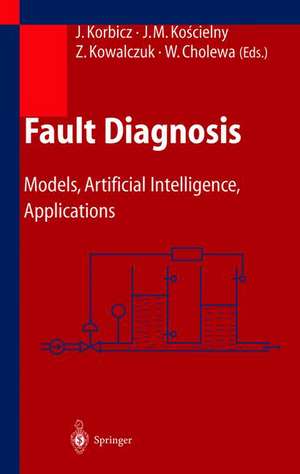Fault Diagnosis: Models, Artificial Intelligence, Applications
Editat de Józef Korbicz, Jan M. Koscielny, Zdzislaw Kowalczuk, Wojciech Cholewaen Limba Engleză Hardback – 30 noi 2003
| Toate formatele și edițiile | Preț | Express |
|---|---|---|
| Paperback (1) | 1785.43 lei 38-44 zile | |
| Springer Berlin, Heidelberg – 5 noi 2012 | 1785.43 lei 38-44 zile | |
| Hardback (1) | 1937.02 lei 6-8 săpt. | |
| Springer Berlin, Heidelberg – 30 noi 2003 | 1937.02 lei 6-8 săpt. |
Preț: 1937.02 lei
Preț vechi: 2421.28 lei
-20% Nou
Puncte Express: 2906
Preț estimativ în valută:
370.69€ • 402.52$ • 311.38£
370.69€ • 402.52$ • 311.38£
Carte tipărită la comandă
Livrare economică 22 aprilie-06 mai
Preluare comenzi: 021 569.72.76
Specificații
ISBN-13: 9783540407676
ISBN-10: 3540407677
Pagini: 954
Ilustrații: XXIX, 922 p.
Dimensiuni: 155 x 235 x 49 mm
Greutate: 1.5 kg
Ediția:2004
Editura: Springer Berlin, Heidelberg
Colecția Springer
Locul publicării:Berlin, Heidelberg, Germany
ISBN-10: 3540407677
Pagini: 954
Ilustrații: XXIX, 922 p.
Dimensiuni: 155 x 235 x 49 mm
Greutate: 1.5 kg
Ediția:2004
Editura: Springer Berlin, Heidelberg
Colecția Springer
Locul publicării:Berlin, Heidelberg, Germany
Public țintă
ResearchDescriere
All real systems in nature - physical, biological and engineering ones - can malfunction and fail due to faults in their components. Logically,the chances for malfunctions increase with the systems' complexity. The complexity of engineering systems is permanently growing due to their growing size and the degree of automation, and accordingly increasing is the danger of fail ing and aggravating their impact for man and the environment. Therefore, in the design and operation of engineering systems, increased attention has to be paid to reliability, safety and fault tolerance. But it is obvious that, compared to the high standard of perfection that nature has achieved with its self-healing and self-repairing capabilities in complex biological organisms, fault management in engineering systems is far behind the standards of their technological achievements; it is still in its infancy, and tremendous work is left to be done. In technical control systems, defects may happen in sensors, actuators, components of the controlled object - the plant, or in the hardware or soft ware of the control framework. Such defects in the components may develop into a failure of the whole system. This effect can easily be amplified by the closed loop, but the closed loop may also hide an incipient fault from be ing observed until a situation has occurred in which the failing of the whole system has become unavoidable.
Cuprins
1. Introduction.- 2. Models in the diagnostics of processes.- 3. Process diagnostics methodology.- 4. Methods of signal analysis.- 5. Control theory methods in designing diagnostic systems.- 6. Optimal detection observers based on eigenstructure assignment.- 7. Robust H?-optimal synthesis of FDI systems.- 8. Evolutionary methods in designing diagnostic systems.- 9. Artificial neural networks in fault diagnosis.- 10. Parametric and neural network Wiener and Hammerstein models in fault detection and isolation.- 11. Application of fuzzy logic to diagnostics.- 12. Observers and genetic programming in the identification and fault diagnosis of non-linear dynamic systems.- 13. Genetic algorithms in the multi-objective optimisation of fault detection observers.- 14. Pattern recognition approach to fault diagnostics.- 15. Expert systems in technical diagnostics.- 16. Selected methods of knowledge engineering in systems diagnosis.- 17. Methods of acqusition of diagnostic knowledge.- 18. State monitoring algorithms for complex dynamic systems.- 19. Diagnostics of industrial processes in decentralised structures.- 20. Detection and isolation of manoeuvres in adaptive tracking filtering based on multiple model switching.- 21. Detecting and locating leaks in transmission pipelines.- 22. Models in the diagnostics of processes.- 23. Diagnostic systems.
Recenzii
From the reviews of the first edition:
"This is an extremely full treatment of its topic, with a total of 23 chapters by different groups of authors … . ‘The book on hand is one of the few comprehensive works on the market covering the fundamentals of model-based fault diagnosis … ’. This is an impressively comprehensive and well-prepared work. Each chapter begins with an introduction and ends with a summary, and is followed by an extensive list of references." (Alex M. Andrew, Kybernetes, Vol. 34 (5), 2005)
"This book presents descriptions of modern diagnosis methods which are based on control engineering. … the goal of the book is to present in a coherent way various research methods … . The book contains most of the modern control methods which are used in fault diagnosis and wide bibliographical information. The book is a good introduction to fault diagnosis and may be very useful for students, post graduate students, engineers and scientists who deal with industrial control systems to guarantee their safety." (Yuri N. Sankin, Zentralblatt MATH, Vol. 1074, 2005)
"This is an extremely full treatment of its topic, with a total of 23 chapters by different groups of authors … . ‘The book on hand is one of the few comprehensive works on the market covering the fundamentals of model-based fault diagnosis … ’. This is an impressively comprehensive and well-prepared work. Each chapter begins with an introduction and ends with a summary, and is followed by an extensive list of references." (Alex M. Andrew, Kybernetes, Vol. 34 (5), 2005)
"This book presents descriptions of modern diagnosis methods which are based on control engineering. … the goal of the book is to present in a coherent way various research methods … . The book contains most of the modern control methods which are used in fault diagnosis and wide bibliographical information. The book is a good introduction to fault diagnosis and may be very useful for students, post graduate students, engineers and scientists who deal with industrial control systems to guarantee their safety." (Yuri N. Sankin, Zentralblatt MATH, Vol. 1074, 2005)
Textul de pe ultima copertă
This comprehensive work presents the status and likely development of fault diagnosis, which has become an emerging discipline of modern control engineering. It covers the fundamentals of model-based fault diagnosis in a wide context relevant to industrial engineers and scientists as well as academics pursuing the reliability and fault detection issues of safety-critical industrial processes. The wide scope of the book provides graduate and postgraduate students of control and mechanical engineering or system sciences with a good introduction to the theoretical foundation and many basic approaches of fault detection, while providing useful bibliographical information. It is a valuable reference book and practical help for industrial control engineers who are in charge of the improvement and safety of the technical control systems, condition-based maintenance and repair, or of the design of fault tolerant control systems.
Caracteristici
State of the art in process diagnostics presented in a handbook like style
Includes supplementary material: sn.pub/extras
Includes supplementary material: sn.pub/extras



















